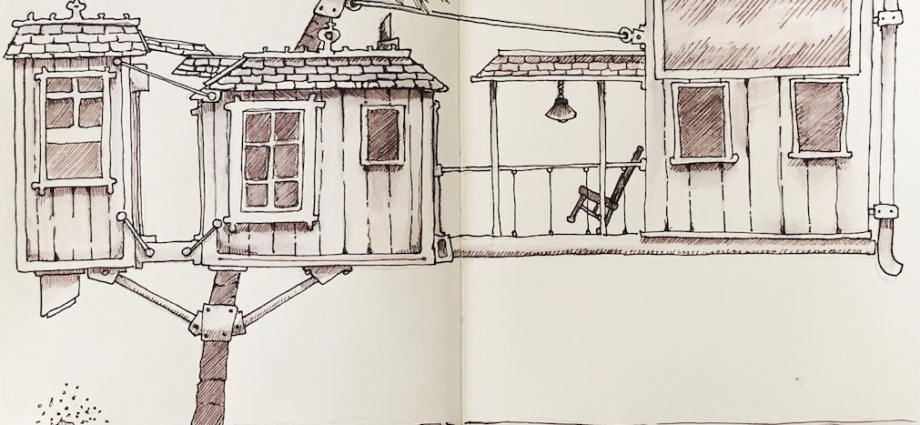Launching new blogs and post series
Ann Morgan, the London-based author who once read her way around the world, launched a new blog, A Journal of the Plague Year, to “explore the shifts that this period will bring,” she writes. Heather Mason, a blogger in Johannesburg, started a Joburg COVID-19 Lockdown Journal, filed under the “lockdown” tag of her blog, 2Summers.

Blogging is also very much a collaborative and cathartic activity, and some writers have come together — on group sites like delirium.blog — to share meditations, rants, and the half-baked messages scribbled in their notebooks.
In this spirit of community, Nicole Melancon at Thirdeyemom published an update, “Hello from Minnesota,” on how she’s doing in her corner of the world, encouraging readers to do the same and virtually check in with each other.
Sharing and documenting through art
Many artists and educators are inspiring people to tap into their creativity at home. Danny Gregory, based in New York City, hosts live drawing parties online, sharing tips from his Sketchbook Skool archive. Illustrator Mica Angela Hendricks resurfaced on her blog, Busy Mockingbird, to share black-and-white sketches for use as coloring pages.
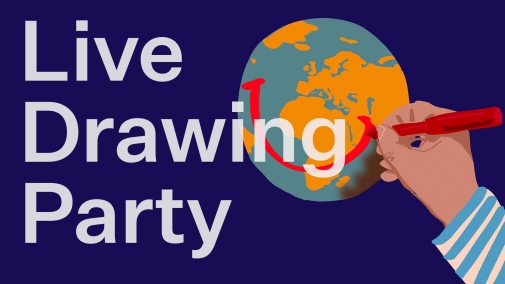
Other artists are publishing pandemic-themed posts on a regular basis, like Wellington-based cartoonist Sarah Laing, who publishes daily comics in her COVID-19 Diaries series, or the illustrator at Ink & Paint, who is participating in an art challenge and creating sketches each day.
People are reflecting, journaling, and creating — as well as motivating each other — which is lovely to see. Here’s a small sample of posts we read and loved this week, from cultural commentary to personal musings, with art sprinkled in.
“How to expand subjective time during the lockdown,” Ted Cooke, Conscious Cookies
“Time in the lockdown can slip away from us, and disturb our mental tranquility,” Ted Cooke writes in a post on the mapping of time to space. It’s at once thought-provoking and actionable, including tips on living and working in a confined space during this period of isolation.
And this is why a day spent all in one spot will tend to feel like it’s passed quicker: as we experience the sequence of activities in our day, each is a little bit less distinctive and differentiated than it would be under normal conditions because it lacks spatial context, and the different portions of the day then bleed into each other.
This interfusion of the different parts of the day diminishes them all. Your yoga headspace carries into your work headspace carries into your argument with your flatmate headspace carries into your creative time headspace, and the resources of your mind are never fully focused on any one of these things.
And this lack of distinctness to individual moments in your day has its flip side in memory, where because there are no spatial hooks for it to gain purchase on, it becomes difficult to remember what we did: there are no differentiated locations to trigger recollection. It’s as if all the photographs have been made on top of each other on a single print.
“Why I’m Giving Myself Permission to Keep Writing at This Time,” Sari Botton, Longreads
Is it okay to think and write about something other than the virus? Do our stories even matter right now? Sari Botton, the essays editor at Longreads, works through these questions and ultimately thinks the effort is worthwhile.
I think often of a George Eliot quote: “It’s never too late to be what you might have been.” But my grandmothers didn’t live long enough to be who they might have been. Maybe I am getting to. Maybe my story about that will affect someone else — while I’m alive, and later, when I’m gone. Maybe it’s true what they say, that you teach what you most need to learn; clearly I wouldn’t be in the line of work I’m in, helping people tell their stories, if I didn’t believe people’s stories matter.
So that settles it: My story matters, and so does yours. I’m giving myself permission to write as I feel called to through this dark time. And if you need permission from someone other than yourself, I’m giving it to you, too. I’m not shirking any responsibilities to do it. I’m helping others out, staying connected to loved ones, making donations to helpful organizations as I can, doing my job. But when I am so motivated, I’m going to take a moment to write about what is happening, inside me and around me. I will tell myself first what I think and feel, and maybe later, share it with the world.
“Home Sweet Home Sweet Home,” Pete Scully, Pete Scully’s Sketch Blog
Originally from north London and now in Northern California, artist Pete Scully shares scenes from inside his home. “Working from home, this is where I sit. I’m there right now too. I’m here a lot. This was another late evening sketch, drawn from the dinner table. On the screen are the latest coronavirus numbers. Even though this was only a few days ago the numbers are so much worse; we are no closer to flattening this curve.”

“This is not my first rodeo (real talk about getting through this),” Raq Winchester, InBLOGnito
Raq Winchester has served as a U.S. federal employee overseas and is also the spouse of a Foreign Service Officer. On her blog, she shares learnings from many years of facing pandemics and lockdowns around the world.
You will also not have to train your kids how and when to use the panic room, or do weekly drills on using the radio to call Post 1 (the Marine on duty at the embassy). You will not have to train your kids how to behave when they are kidnapped, or how to give the kidnappers instructions, in English and Spanish, to call the US Embassy. You probably won’t have to teach them how to deal with exposure to tear gas.
My point is: when you are ready to tear your hair out, remember that it could be worse. You’ll get through this.
“Forward,” Lucy Grove Jones, Silence Killed the Dinosaurs
Despite an incredibly challenging year so far — facing her fourth miscarriage, a bushfire evacuation, and now the pandemic — artist Lucy Grove Jones focuses on a single word: forward. “It means the future is coming. It means keep going, there’s more. It means you can’t go back, so don’t wait around.”
I’m worried about what happens when I run out of toilet paper because everyone else has panic-hoarded it. I’m worried about my older relatives. I’m worried about my chronically ill friends. I’m worried about my siblings—both of whom are doctors working in hospitals. I’m worried that next fire season a bushfire will reach my town, my home. I’m worried I’ll just keep miscarrying forever. I’m worried about lurking tumours. I’m worried about living in a country with a marginal environment and unsustainable habits while the world gets hotter.
It’s scary outside, and it’s dark inside.
Forward is not about choice. It’s going to happen anyway. The future is coming, and you can’t go back.
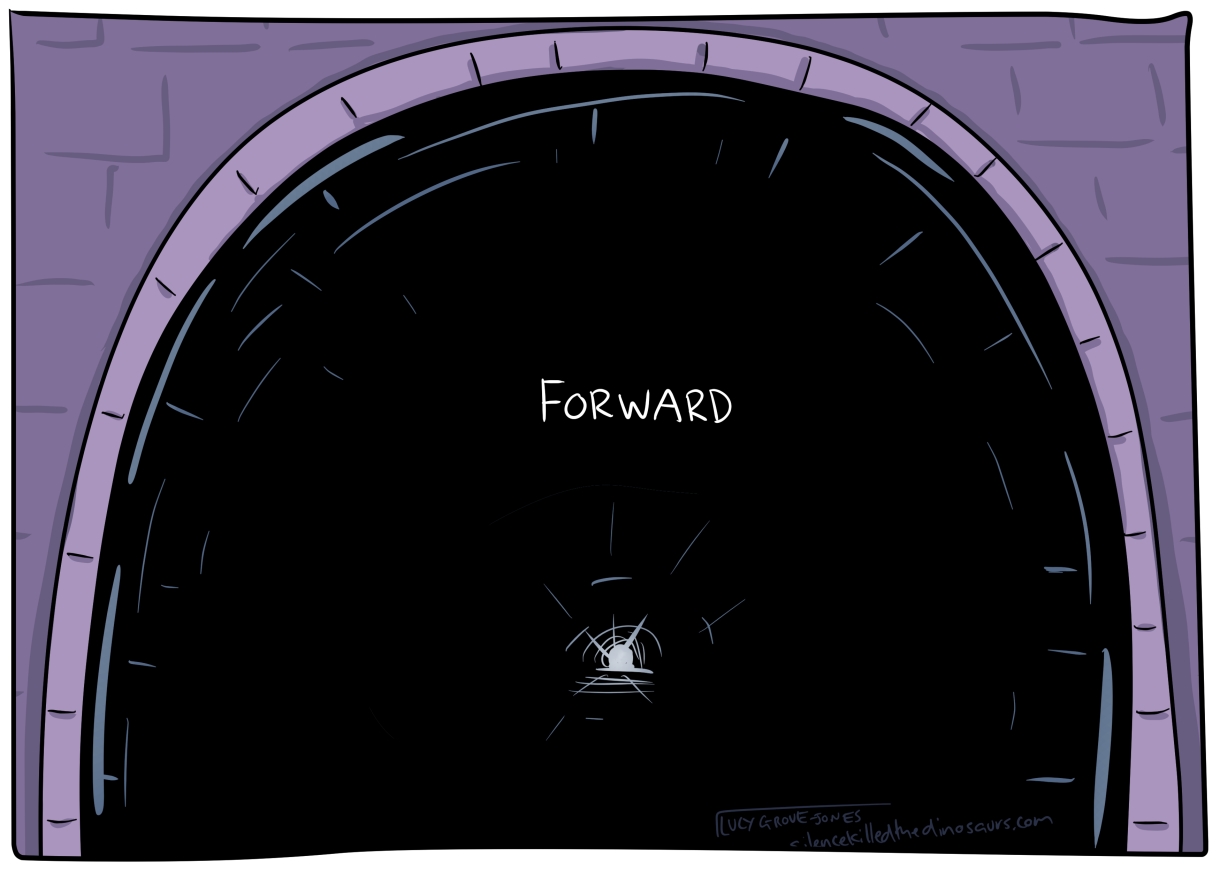
“What studying disasters has taught me about COVID-19,”LibrarianShipwreck
“For the last several years, when people have asked me what I study, I have told them that I study the end of the world.” At LibrarianShipwreck — a blog on technology, critical theory, and impending doom — the writer shares context and framing around what we’re all learning and reading about COVID-19.
Forgive the US centric focus here, but: that millions of Americans don’t have access to paid sick leave is a slow disaster, the racism endemic in the provision of medical care is a slow disaster, that hospitals around the country are already stretched thin is a slow disaster, homelessness is a slow disaster, heck the entire US healthcare system could be called a slow disaster—when the situation is “normal” many of these problems may not appear particularly disastrous (alas) but when an event like a pandemic occurs these slow disasters provide a rotten foundation atop which things can only get worse.
It is fair to think about COVID-19 as a disaster, and it is probably going to get worse before it gets better. Yet, when assessing COVID-19 it is worth stepping back and recognizing all of the disasters that have quietly and slowly built up over time which are feeding directly into, and are exacerbating, this crisis.
“Performance Art: On Sharing Culture,” Soraya Roberts, Longreads
Soraya Roberts is always on point in her culture columns at Longreads, and her piece on social sharing and physical distancing in a time when landmarks, cultural institutions, and communal spaces have been abandoned is no exception.
The image that struck me most was the empty piazza. That Italian square — I believe it was in Venice — with no one in it. Maybe a bird or two. It looked inviting but also wholly unnatural. A city square is made for people, lots of people, people from everywhere. If people aren’t there, does it cease to be a square? I wondered the same thing about the Louvre and its tens of thousands of objects with no one to look at them — is it still a museum, or is it just a warehouse?
Sharing online is not so much about enlightening others as it is about spotlighting yourself. It’s impossible to disconnect the images of those now-empty spots from the continuous splash of reports about the coronavirus pandemic gouging the global economy. In America, the economy is the culture is the people. Americans are not citizens; they are, as the president recently put it, “consumers.” And on the web, consuming means sharing that consumption with everyone else. That the images suddenly being shared are empty exposes the big con — that in reality, no one has really been sharing anything.
“Pandemic Playlist,” John Atkinson, Wrong Hands
As usual, Wrong Hands cartoonist John Atkinson shares lighthearted and humorous comics, which are very welcome right now. Here’s his playlist of pandemic-inspired tunes.
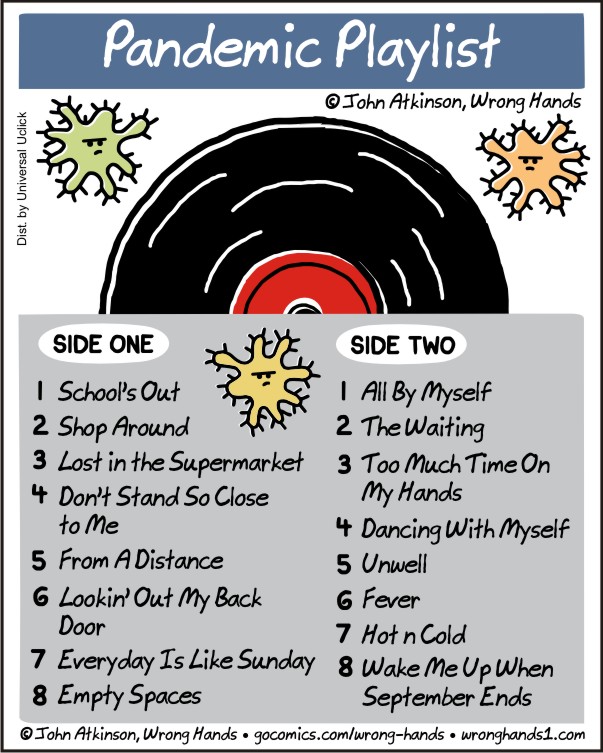
“On Writing and the Pandemic,” Lanny Morgnanesi, NotebookM
Writer and journalist Lanny Morgnanesi muses on not being able to write, and instead reads and reflects on the work of Joan Didion, specifically a piece called “California Notes” in the New York Review of Books.
There’s a famous Nora Ephron quote that reminds me of Joan and has been repeated in this time of crisis: “Everything is copy.” I always thought it peculiar that such a quote would become so famous, since few outside of writing know what “copy” is. The reason must be because writers are the ones always repeating the quote. Anyway, “copy” in this sense means “material” for writing, and now – with the world shut down by a virus — everything is indeed copy. You go outside for a walk and it’s copy. You venture out and drive through town and it’s copy. You cook a meal or seek activities for your kids and it’s copy.
“When the World Wakes Up, and We Are All Inside,” P.L. Thomas, Radical Eyes for Equity
An avid cyclist, P.L. Thomas has thought of himself as an outdoor person but not a nature person, but with social distancing guidelines in place, he experiences an unexpected shift in how he views the natural world.
As we were cycling laps around a park in my hometown, a friend and I talked about my new fascination with wisteria and we both acknowledge not really knowing the names of trees and plants all coming to bloom around the lake at the center of this park.
It seems a different kind of important now to see the various plants and trees individually, and to know their names.
That day we were climbing Hogback I recall now that I did pause at the top, I did look at the view, and I had to agree it was more than worth my time to not just look, but really see the view from above the trees and across the valley.
“The Walk,” Sarah Laing, Let Me Be Frank
Sarah Laing, an artist in Wellington, New Zealand, publishes “pretty spontaneous and autobiographical” comics, often about her everyday experiences. She’s in the midst of a COVID-19 Diaries series; here’s a scene from “The Walk.”
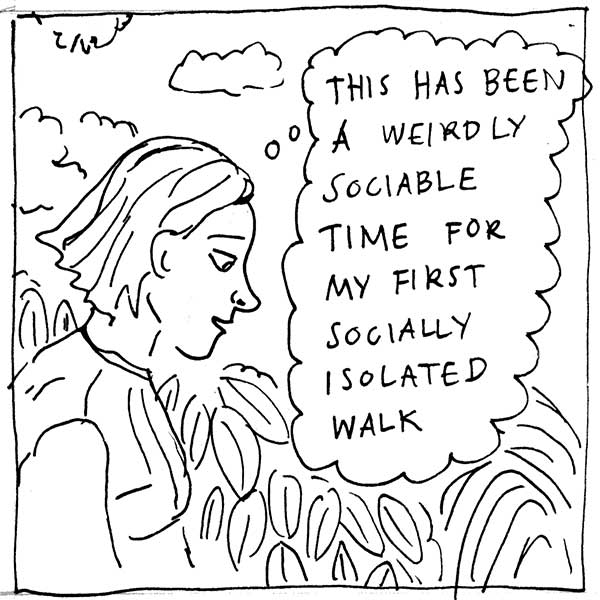
“In the Midst of It All,” Ben Hewitt, Lazy Mill Hill Farm
Author Ben Hewitt runs a small-scale community farm in Vermont. His blog at Lazy Mill Hill Farm offer a glimpse into the slower pace of life on his family’s land. Posts are typically short yet resonant, like this one.
The virus spreads. The stock market plunges. The cows nose at the newly bare ground beneath the big spruce. The cats mewl at the door. The pumpkin has been there over a week now. It’s not been particularly cold, but cold enough that I suspect the man has burned his wheelchair load of wood and has since gone back for more. Some things are changing, some things are not, but in the midst of it all, the fire must still be fed.
“The Virus Diaries 4,” Neil Murray
Neil Murray, an artist and photographer in Florida, has begun a series of sketches called “The Virus Diaries.” With people sheltered-in-place at home, his fourth sketch really nails it.
Dear diary,
The house seems much smaller than it did two weeks ago.

Writing and art in response to the COVID-19 crisis.
via Blogging in the Time of Coronavirus: A Reading List — Discover
